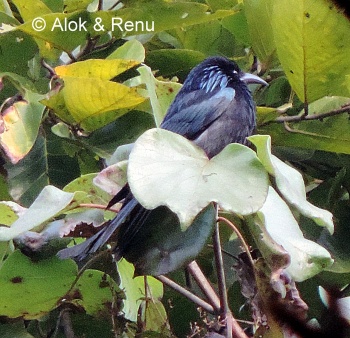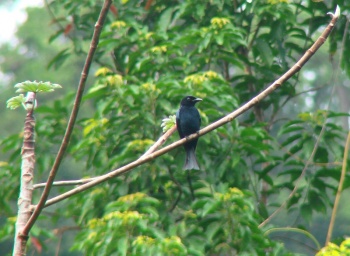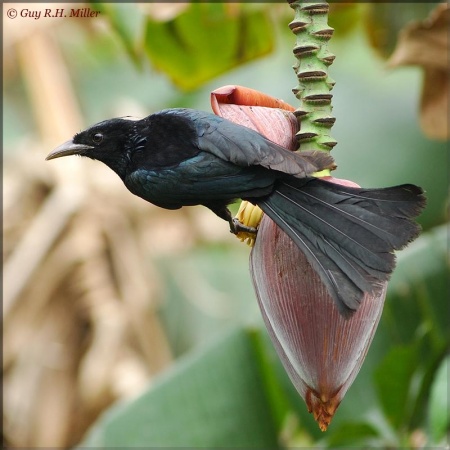(subspecies range) |
(→External Links: New combined GSearch. GSearch checked template) |
||
| (13 intermediate revisions by 5 users not shown) | |||
| Line 1: | Line 1: | ||
| − | [[Image:Hair-crested_Drongo.jpg|thumb| | + | [[Image:Hair-crested_Drongo.jpg|thumb|450px|right|ssp ''brevirostris''<br />Photo © by {{user|anonymous_guy|anonymous_guy}}<br/>Lamma Island, [[Hong Kong]], April 2005]] |
;[[:Category:Dicrurus|Dicrurus]] hottentottus | ;[[:Category:Dicrurus|Dicrurus]] hottentottus | ||
| + | '''Includes: White-eyed Spangled Drongo, Obi Spangled Drongo, Sula Spangled Drongo, Sulu Spangled Drongo''' | ||
==Identification== | ==Identification== | ||
| − | 25 - 32cm. A variable species. Features of the nominate subspecies are: | + | [[Image:hair-crested _drongo_alok.JPG|thumb|350px|right|Nominate subspecies showing spangles and hackles<br />Photo © by {{user|aloktewari|Alok Tewari}}<br/>Dudhwa National Park, Lakhimpur Kheri, Uttar Pradesh, [[India]], January-2015]] |
| + | 25 - 32cm (9¾-12½ in). A variable species. Features of the nominate subspecies are: | ||
* Long hair-like feathers springing from forehead, extending over hindcrown and upper back (not in all subspecies) | * Long hair-like feathers springing from forehead, extending over hindcrown and upper back (not in all subspecies) | ||
* Black plumage, brightly glossed metallic blue-green | * Black plumage, brightly glossed metallic blue-green | ||
* Numerous breast spangles and broad and very large, long and glossy neck hackles | * Numerous breast spangles and broad and very large, long and glossy neck hackles | ||
| − | * Tail nearly square-ended, inner four pairs of rectrices ending almost at same level as outer pair | + | * Tail nearly square-ended, inner four pairs of [[Topography#Tails|rectrices]] ending almost at same level as outer pair |
* Reddish-brown or dark brown eye | * Reddish-brown or dark brown eye | ||
| − | Sexes similar, females are duller. Juveniles are browner and less glossed. | + | Sexes similar, females are duller. Juveniles are browner and less glossed. |
| − | |||
==Distribution== | ==Distribution== | ||
Found on the [[India]]n Subcontinent, in the [[Himalayas]], [[Burma]], big parts of [[China]], [[Indochina]] and on [[Borneo]], [[Sulawesi]] and parts of the [[Philippines]] (see taxonomy).<br /> | Found on the [[India]]n Subcontinent, in the [[Himalayas]], [[Burma]], big parts of [[China]], [[Indochina]] and on [[Borneo]], [[Sulawesi]] and parts of the [[Philippines]] (see taxonomy).<br /> | ||
Locally common. Some island subspecies are under threat due to deforestation. | Locally common. Some island subspecies are under threat due to deforestation. | ||
==Taxonomy== | ==Taxonomy== | ||
| − | [[Image:Spangled Drongo3.JPG|thumb|350px|right|ssp ''striatus''<br />Photo by {{user|Mark+Bruce|Mark Bruce}}<br />PICOP, Bislig, Mindanao Island, [[Philippines]], January 2009]] | + | [[Image:Spangled Drongo3.JPG|thumb|350px|right|ssp ''striatus'' - Balicassiao<br />Photo by {{user|Mark+Bruce|Mark Bruce}}<br />PICOP, Bislig, Mindanao Island, [[Philippines]], January 2009]] |
| − | + | Taxonomy is complex and not well understood. Studies suggest there are several species within the taxon. The following subspecies may be elevated to species status: ''banggaiensis'' and ''leucops'' ("White-eyed Spangled Drongo", ''D. leucops''), ''guillemardi'' ("Obi Spangled Drongo", ''D. guillemardi''); ''pectoralis'' ("Sula Spangled Drongo", ''D. pectoralis''); and ''suluensis'' ("Sulu Spangled Drongo", ''D. suluensis''). | |
| − | + | ||
| − | * ''D. h. hottentottus'' | + | Hair-crested Drongo been considered conspecific with [[Spangled Drongo]], [[Sumatran Drongo]], [[Wallacean Drongo]], [[Balicassiao]], [[Sulawesi Drongo]] and [[Ribbon-tailed Drongo]] and may form a superspecies with all these forms. |
| − | * ''D. h. brevirostris'' in | + | |
| − | + | [[Tablas Drongo]] was regarded as a subspecies of this species. | |
| − | + | ||
| − | * ''D. h. borneensis'' | + | This is a [[Dictionary_P-S#P|polytypic]] species [[#References|[1]]] consisting of 14 subspecies: |
| − | + | ====Subspecies==== | |
| − | * ''D. h. jentincki'' | + | * ''D. h. hottentottus'': from [[India]] to [[Myanmar]], northern [[Thailand]] and southern [[Indochina]] |
| − | + | * ''D. h. brevirostris'': Breeds in central and southern [[China]] south to northern [[Myanmar]], northern [[Laos]] and northern [[Vietnam]]; most of the population migrates south, wintering in [[Indochina]], [[Thailand]], and Myanmar. [Similar to nominate but smaller bill] | |
| − | * ''D. h. leucops'' | + | * ''D. h. borneensis'': Northern [[Borneo]], Maratua and Matasiri islands. [Blue in general colour, rather short frontal filaments, small and strong bill] |
| − | + | * ''D. h. faberi'': Panaitan Island and islands in Jakarta Bay, western [[Java]]. [Smaller than nominate, deeper black below and with a creamy white eye] | |
| − | * ''D. h. guillemardi'' | + | * ''D. h. jentincki'': Eastern [[Java]], [[Bali]], Masalembu, and Kangean Island. [Similar to ''faberi'' but with a longer tail and less deep black plumage ] |
| − | + | * ''D. h. leucops'': "'''White-eyed Spangled Drongo'''". [[Sulawesi]], Matasiri Island (Java Sea), Sanghie, and Siau. [Similar to ''guillemardi'' but with a white eye (see [[Sulawesi Drongo]])] | |
| − | * ''D. h. pectoralis'' | + | * ''D. h. banggaiensis'': "'''White-eyed Spangled Drongo'''". Banggai Islands, off of eastern [[Sulawesi]]. [Similar to ''guillemardi'' but smaller, frontal filaments only present in some birds, brown eye] |
| − | + | * ''D. h. guillemardi'': "'''Obi Spangled Drongo'''". Central Moluccas (Bisa and Obi). [Well-developed long, broad and very well-glossed neck hackles, brown eye] | |
| − | + | * ''D. h. pectoralis'': "'''Sula Spangled Drongo'''". Sula Islands (Taliabu, Mangola and Sanana). [Similar to ''guillemardi'' but smaller, longer and broader hackles and a red eye] | |
| − | + | ||
| − | + | The following subspecies were regarded as a part of the [[Spangled Drongo]] complex by some authorities [[#References|[1]]] but are now commonly included in this species: | |
| − | + | ||
| − | The following subspecies were regarded as a part of the [[Spangled Drongo]] complex by some authorities | + | * ''D. h. palawanensis'': Southern [[Philippines]] (Palawan, Busuanga, Mapun, Culion, Balabac). [Similar to borneensis but with red eye, no frontal filaments and four inner pairs of rectrices becoming gradually longer, tips of outermost with with slight tendency to curl upwards] |
| − | * ''D. h. | + | * ''D. h. cuyensis'': Philippines (Cuyo and Semirara). [Similar to palawanensis but with strongly greenish gloss] |
| − | + | * ''D. h. suluensis'': "'''Sulu Spangled Drongo'''". Sulu Archipelago. [Frontal filaments always present, more deeply forked tail than otherwise similar ''pectoralis''] | |
| − | + | * ''D. h. samarensis'': [[Philippines]] (Bohol, Leyte, Panaon, Samar and Calicoan). [Very short, straight and square-ended tail, no frontal filaments] | |
| − | + | * ''D. h. striatus'': Southern Philippines (Basilan, Mindanao and Nipa). [Similar to ''samarensis'' but tail a little longer and slightly forked] | |
| − | * ''D. h. cuyensis'' | + | |
| − | + | ==Gallery== | |
| − | * ''D. h. | + | Click on photo for larger image |
| − | |||
| − | |||
| − | |||
| − | |||
| − | |||
<gallery> | <gallery> | ||
| − | Image:8718hair crested drongo.jpg|Photo by {{user|obasanmi|obasanmi}}<br />ssp ''leucops''<br />Tangkoko, [[Sulawesi]], [[Indonesia]], October 2005 | + | Image:8718hair crested drongo.jpg|Photo © by {{user|obasanmi|obasanmi}}<br />ssp ''leucops''<br />[[Tangkoko]], [[Sulawesi]], [[Indonesia]], October 2005 |
| − | Image:Drongo.jpg|Photo by {{user|Karim+Madoya|Karim Madoya}}<br />ssp ''borneensis''<br />Kinabalu National Park, [[Borneo]], [[Malaysia]], December 2007 | + | Image:Drongo.jpg|Photo © by {{user|Karim+Madoya|Karim Madoya}}<br />ssp ''borneensis''<br />Kinabalu National Park, [[Borneo]], [[Malaysia]], December 2007 |
| − | Image:90261095 57GwO7k.jpg|Photo by {{user|Ayuwat+J|Ayuwat J}}<br />nominate subspecies<br />Doi Angkhang, Chiangmai, [[Thailand]] | + | Image:90261095 57GwO7k.jpg|Photo © by {{user|Ayuwat+J|Ayuwat J}}<br />nominate subspecies<br />Doi Angkhang, Chiangmai, [[Thailand]] |
</gallery> | </gallery> | ||
==Habitat== | ==Habitat== | ||
Found in different types of forest, preferring broadleaf evergreen and moist deciduous forest. Occurs from sea-level up to 1500m, occasionally up to 2000m. | Found in different types of forest, preferring broadleaf evergreen and moist deciduous forest. Occurs from sea-level up to 1500m, occasionally up to 2000m. | ||
==Behaviour== | ==Behaviour== | ||
| − | They move singly or in small flocks and are very noisy. | + | They move singly or in small flocks and are very noisy. |
| − | Feeds on insects and nectar. Also reported to hawk for lizards. | + | ====Diet==== |
| − | Breeding season poorly documented, from April to June in northern [[India]], April to July in southwest [[Asia]]. Very noisy and aggressive towards disturbance while breeding. The nest is a deep saucer made of grass, rootlets and tendrils of creepers. It's usually placed in a tree but also reported in bamboo in [[China]]. Lays 3 - 4 eggs. | + | Feeds on insects and nectar. Also reported to hawk for lizards. |
| + | ====Breeding==== | ||
| + | Breeding season poorly documented, from April to June in northern [[India]], April to July in southwest [[Asia]]. Very noisy and aggressive towards disturbance while breeding. The nest is a deep saucer made of grass, rootlets and tendrils of creepers. It's usually placed in a tree but also reported in bamboo in [[China]]. Lays 3 - 4 eggs. | ||
| + | ====Movements==== | ||
Most populations are resident but birds in the northern part of the distribution ([[China]]) migrate south to [[Indochina]]. | Most populations are resident but birds in the northern part of the distribution ([[China]]) migrate south to [[Indochina]]. | ||
==References== | ==References== | ||
| − | #{{Ref- | + | #{{Ref-Clements6thAug21}}#{{Ref-HBWVol14}} |
{{Ref}} | {{Ref}} | ||
==External Links== | ==External Links== | ||
| − | {{GSearch|Dicrurus | + | {{GSearch|"Dicrurus hottentottus" {{!}} "Hair-crested Drongo" {{!}} "White-eyed Spangled Drongo" {{!}} "Obi Spangled Drongo" {{!}} "Sula Spangled Drongo" {{!}} "Sulu Spangled Drongo"}} |
| + | {{GS-checked}}1 | ||
| + | <br /> | ||
| + | <br /> | ||
| + | |||
[[Category:Birds]] [[Category:Dicrurus]] | [[Category:Birds]] [[Category:Dicrurus]] | ||
Latest revision as of 19:11, 2 October 2023
- Dicrurus hottentottus
Includes: White-eyed Spangled Drongo, Obi Spangled Drongo, Sula Spangled Drongo, Sulu Spangled Drongo
Identification

Photo © by Alok Tewari
Dudhwa National Park, Lakhimpur Kheri, Uttar Pradesh, India, January-2015
25 - 32cm (9¾-12½ in). A variable species. Features of the nominate subspecies are:
- Long hair-like feathers springing from forehead, extending over hindcrown and upper back (not in all subspecies)
- Black plumage, brightly glossed metallic blue-green
- Numerous breast spangles and broad and very large, long and glossy neck hackles
- Tail nearly square-ended, inner four pairs of rectrices ending almost at same level as outer pair
- Reddish-brown or dark brown eye
Sexes similar, females are duller. Juveniles are browner and less glossed.
Distribution
Found on the Indian Subcontinent, in the Himalayas, Burma, big parts of China, Indochina and on Borneo, Sulawesi and parts of the Philippines (see taxonomy).
Locally common. Some island subspecies are under threat due to deforestation.
Taxonomy

Photo by Mark Bruce
PICOP, Bislig, Mindanao Island, Philippines, January 2009
Taxonomy is complex and not well understood. Studies suggest there are several species within the taxon. The following subspecies may be elevated to species status: banggaiensis and leucops ("White-eyed Spangled Drongo", D. leucops), guillemardi ("Obi Spangled Drongo", D. guillemardi); pectoralis ("Sula Spangled Drongo", D. pectoralis); and suluensis ("Sulu Spangled Drongo", D. suluensis).
Hair-crested Drongo been considered conspecific with Spangled Drongo, Sumatran Drongo, Wallacean Drongo, Balicassiao, Sulawesi Drongo and Ribbon-tailed Drongo and may form a superspecies with all these forms.
Tablas Drongo was regarded as a subspecies of this species.
This is a polytypic species [1] consisting of 14 subspecies:
Subspecies
- D. h. hottentottus: from India to Myanmar, northern Thailand and southern Indochina
- D. h. brevirostris: Breeds in central and southern China south to northern Myanmar, northern Laos and northern Vietnam; most of the population migrates south, wintering in Indochina, Thailand, and Myanmar. [Similar to nominate but smaller bill]
- D. h. borneensis: Northern Borneo, Maratua and Matasiri islands. [Blue in general colour, rather short frontal filaments, small and strong bill]
- D. h. faberi: Panaitan Island and islands in Jakarta Bay, western Java. [Smaller than nominate, deeper black below and with a creamy white eye]
- D. h. jentincki: Eastern Java, Bali, Masalembu, and Kangean Island. [Similar to faberi but with a longer tail and less deep black plumage ]
- D. h. leucops: "White-eyed Spangled Drongo". Sulawesi, Matasiri Island (Java Sea), Sanghie, and Siau. [Similar to guillemardi but with a white eye (see Sulawesi Drongo)]
- D. h. banggaiensis: "White-eyed Spangled Drongo". Banggai Islands, off of eastern Sulawesi. [Similar to guillemardi but smaller, frontal filaments only present in some birds, brown eye]
- D. h. guillemardi: "Obi Spangled Drongo". Central Moluccas (Bisa and Obi). [Well-developed long, broad and very well-glossed neck hackles, brown eye]
- D. h. pectoralis: "Sula Spangled Drongo". Sula Islands (Taliabu, Mangola and Sanana). [Similar to guillemardi but smaller, longer and broader hackles and a red eye]
The following subspecies were regarded as a part of the Spangled Drongo complex by some authorities [1] but are now commonly included in this species:
- D. h. palawanensis: Southern Philippines (Palawan, Busuanga, Mapun, Culion, Balabac). [Similar to borneensis but with red eye, no frontal filaments and four inner pairs of rectrices becoming gradually longer, tips of outermost with with slight tendency to curl upwards]
- D. h. cuyensis: Philippines (Cuyo and Semirara). [Similar to palawanensis but with strongly greenish gloss]
- D. h. suluensis: "Sulu Spangled Drongo". Sulu Archipelago. [Frontal filaments always present, more deeply forked tail than otherwise similar pectoralis]
- D. h. samarensis: Philippines (Bohol, Leyte, Panaon, Samar and Calicoan). [Very short, straight and square-ended tail, no frontal filaments]
- D. h. striatus: Southern Philippines (Basilan, Mindanao and Nipa). [Similar to samarensis but tail a little longer and slightly forked]
Gallery
Click on photo for larger image
Photo © by Karim Madoya
ssp borneensis
Kinabalu National Park, Borneo, Malaysia, December 2007
Habitat
Found in different types of forest, preferring broadleaf evergreen and moist deciduous forest. Occurs from sea-level up to 1500m, occasionally up to 2000m.
Behaviour
They move singly or in small flocks and are very noisy.
Diet
Feeds on insects and nectar. Also reported to hawk for lizards.
Breeding
Breeding season poorly documented, from April to June in northern India, April to July in southwest Asia. Very noisy and aggressive towards disturbance while breeding. The nest is a deep saucer made of grass, rootlets and tendrils of creepers. It's usually placed in a tree but also reported in bamboo in China. Lays 3 - 4 eggs.
Movements
Most populations are resident but birds in the northern part of the distribution (China) migrate south to Indochina.
References
- Clements, J. F., T. S. Schulenberg, M. J. Iliff, S. M. Billerman, T. A. Fredericks, J. A. Gerbracht, D. Lepage, B. L. Sullivan, and C. L. Wood. 2021. The eBird/Clements checklist of Birds of the World: v2021. Downloaded from https://www.birds.cornell.edu/clementschecklist/download/
- Del Hoyo, J, A Elliott, and D Christie, eds. 2009. Handbook of the Birds of the World. Volume 14: Bush-shrikes to Old World Sparrows. Barcelona: Lynx Edicions. ISBN 978-8496553507
Recommended Citation
- BirdForum Opus contributors. (2024) Hair-crested Drongo. In: BirdForum, the forum for wild birds and birding. Retrieved 2 May 2024 from https://www.birdforum.net/opus/Hair-crested_Drongo
External Links
GSearch checked for 2020 platform.1







